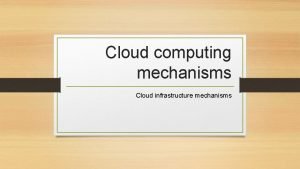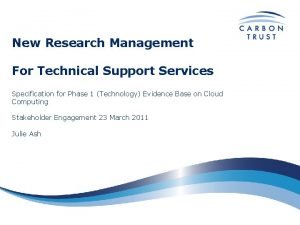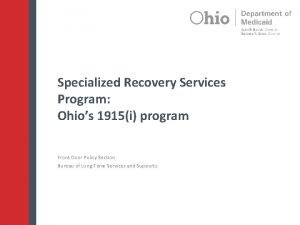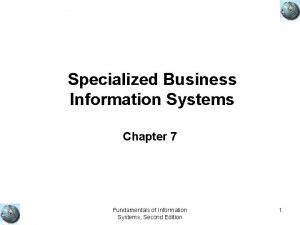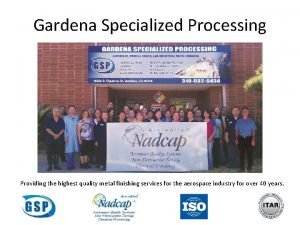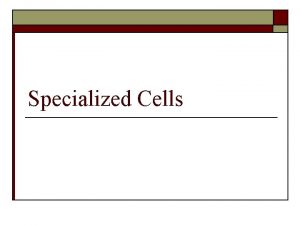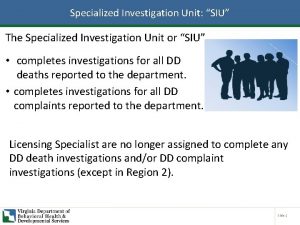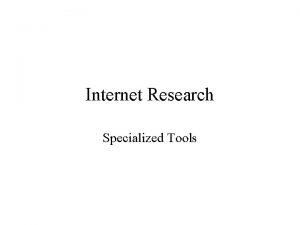Specialized Cloud Mechanisms Specialized mechanisms in support of








































- Slides: 40

Specialized Cloud Mechanisms

Specialized mechanisms in support of one or more cloud characteristics. • Automatic Scaling Listener • Load Balancer • Pay-per-use Monitor • Audit Monitor • Failover Systems • Hypervisor • Resource Cluster • Multi-Device Broker • State Management Database ü Considered as an extension to Cloud infrastructure. ü Combined to offer distinct and custom architecture.

Automatic Scaling Listener • This mechanism is a service agent that monitors and tracks communications between cloud service consumers and cloud services for dynamic scaling purposes. • Typically placed near a firewall (or at hypervisor) tracking workload (processing requests) status. • What does it do in general?

• Automatically scaling IT resources out or in based on parameters previously defined by the cloud consumer (commonly referred to as auto-scaling). • Automatic notification of the cloud consumer when workloads exceed current thresholds or fall below allocated resources. • This way, the cloud consumer can choose to adjust its current IT resource allocation.

Case Study (DTGOV) • DTGOV’s physical servers vertically scale virtual server instances, starting with the smallest VM configuration • (1 virtual processor core, 4 GB of virtual RAM) to the largest (128 virtual processor cores, 512 GB of virtual RAM). • Scale-Down – VM resides in the same physical server while being scaled down. • Scale-Up – capacity is doubled. VIM may live migrate VM to other servers (a current one is overcommitted. ) • Auto-scaling settings controlled by cloud consumers determine the runtime behavior of automated scaling listener agents.

• Physical server 1 is overcommitted. VIM live migrates scaled-up VM to the physical server 2.

• Usage remains 15% below the capacity, scaled-down.

Load Balancer • A common approach to horizontal scaling is to balance a workload across two or more IT resources to increase performance and capacity beyond what a single IT resource can provide. • The load balancer mechanism is a runtime agent with logic fundamentally based on this premise.

Load Balancer Functionalities • Asymmetric Distribution – larger workloads are issued to IT resources with higher processing capacities. • Workload Prioritization – workloads are scheduled, queued, discarded, and distributed workloads according to their priority levels. • Content-Aware Distribution – requests are distributed to different IT resources as dictated by the request content.

• A load balancer is programmed or configured with a set of performance and Qo. S rules and parameters with the general objectives of optimizing IT resource usage, avoiding overloads, and maximizing throughput. • The load balancer mechanisms can exist as a: • • • multi-layer network switch • service agent (usually controlled by cloud management software) dedicated hardware appliance dedicated software-based system (common in server operating systems)

SLA Monitor • To specifically observe the runtime performance of cloud services to ensure that they are fulfilling the contractual Qo. S requirements that are published in SLAs.



Pay-per-use Monitor • The pay-per-use monitor mechanism measures cloud- based IT resource usage in accordance with predefined pricing parameters and generates usage logs for fee calculations and billing purposes. • Some typical monitoring variables are: • • request/response message quantity transmitted data volume bandwidth consumption time duration

• Monitor based on service request.


Audit Monitor • The audit monitor mechanism is used to collect audit tracking data for networks and IT resources in support of (or dictated by) regulatory and contractual obligations. • For example, data related to login (whether successful or failed logins, number of attempts, credentials, etc. )


Failover System • A mechanism used to increase reliability and availability. • To establish a clustering technology providing de redundant implementations. • A failover system is configured to automatically switch over to a redundant or standby IT resource instance whenever the currently active IT resource becomes unavailable.

Failover System Configurations • Active-Active • Redundant implementations of the IT resource actively serve the workload synchronously. Load balancing among active instances is required • Active-Passive • A standby or inactive implementation is activated to take over the processing from the IT resource that becomes unavailable, and the corresponding workload is redirected to the instance taking over the operation.



Case Study (DTGOV) • • • DTGOV creates a resilient virtual server to support the allocation of virtual server instances that are hosting critical applications • which are being replicated in multiple data centers. The replicated resilient virtual server has an associated activepassive failover system. Its network traffic flow can be switched between the IT resource instances that are residing at different data centers, if the active instance were to fail.


Hypervisor • A fundamental part of virtualization infrastructure that is primarily used to generate virtual server instances of a physical server. • A hypervisor is generally limited to one physical server and can therefore only create virtual images of that server. • A hypervisor has limited virtual server management features, such as increasing the virtual server’s capacity or shutting it down. • The VIM provides a range of features for administering multiple hypervisors across physical servers.

Hypervisor (2) • Hypervisor software can be installed directly in baremetal servers and provides features for • • • controlling, sharing and scheduling the usage of hardware resources.

Case Study (DTGOV) • • DTGOV has established a virtualization platform in which the same hypervisor software product is running on all physical servers. The VIM coordinates the hardware resources in each data center so that virtual server instances can be created from the most expedient underlying physical server. As a result, cloud consumers are able to lease virtual servers with auto-scaling features. In order to offer flexible configurations, the DTGOV virtualization platform provides live VM migration of virtual servers among physical servers inside the same data center.

Resource Cluster • Cloud-based IT resources that are geographically diverse can be logically combined into groups to improve their allocation and use. • The resource cluster mechanism is used to group multiple IT resource instances so that they can be operated as a single IT resource. • This increases the combined computing capacity, load balancing, and availability of the clustered IT resources.

Resource Cluster (2) • Resource cluster architectures rely on high-speed dedicated network connections, or cluster nodes, between IT resource instances to communicate about • • workload distribution, task scheduling, data sharing, and system synchronization. • A cluster management platform that is running as distributed middleware in all of the cluster nodes is usually responsible for these activities.

Common Resource Cluster Types • Server Cluster – physical and virtual servers clustered to increase performance. Servers are able to live migrate from one to another. • Database Cluster – designed to improve data availability. • Large Dataset Cluster - data partitioning and distribution is implemented so that the target datasets can be efficiently partitioned without compromising data integrity or computing accuracy.

Load balancing and resource replication are implemented through a clusterenabled hypervisor

Loosely-coupled server cluster

Two Basic Types of Resource Cluster • Load Balanced Cluster – This resource cluster specializes in distributing workloads among cluster nodes to increase IT resource capacity while preserving the centralization of IT resource management. • HA Cluster – A high-availability cluster maintains system availability in the event of multiple node failures, and has redundant implementations of most or all of the clustered IT resources. It implements a failover system mechanism that monitors failure conditions and automatically redirects the workload away from any failed nodes.

Case Study (DTGOV)

Multi-device Broker • The multi-device broker mechanism is used to facilitate runtime data transformation so as to make a cloud service accessible to a wider range of cloud service consumer programs and devices.

• Multi-device brokers commonly exist as gateways or incorporate gateway components, such as: • • XML Gateway – transmits and validates XML data • Mobile Device Gateway – transforms the communication protocols used by mobile devices into protocols that are compatible with a cloud service Cloud Storage Gateway – transforms cloud storage protocols and encodes storage devices to facilitate data transfer and storage • The levels at which transformation logic can be created include: • • transport protocols messaging protocols storage device protocols data schemas/data models


State Management Database • A state management database is a storage device that is used to temporarily persist state data for software programs. • As an alternative to caching state data in memory, software programs can off-load state data to the database in order to reduce the amount of runtime memory they consume • By doing so, the software programs and the surrounding infrastructure are more scalable. • State management databases are commonly used by cloud services, especially those involved in long-running runtime activities.


 Specialized cloud mechanisms
Specialized cloud mechanisms Specialized nutritional support
Specialized nutritional support Logical network perimeter
Logical network perimeter Tools and mechanisms of virtualization in cloud computing
Tools and mechanisms of virtualization in cloud computing Ready made environment in cloud computing
Ready made environment in cloud computing Major points examples
Major points examples Technical services support cloud computing
Technical services support cloud computing Public cloud vs private cloud cost analysis
Public cloud vs private cloud cost analysis Snapcloud
Snapcloud Computing refers to
Computing refers to Cloud integration patterns
Cloud integration patterns Who is responsible for providing specialized work footwear
Who is responsible for providing specialized work footwear Types of specialized investments
Types of specialized investments Humss sample schedule
Humss sample schedule Carestar srs program
Carestar srs program Skeletal muscle function
Skeletal muscle function Internal structure of a leaf
Internal structure of a leaf Features of stock exchange
Features of stock exchange Gallahue's hourglass model
Gallahue's hourglass model What is a specialized cell
What is a specialized cell Specialized application software
Specialized application software Specialized devices
Specialized devices Specialized measurements
Specialized measurements Specialized information system
Specialized information system Stem cutting
Stem cutting Specialized structure
Specialized structure Little casears
Little casears Protective equipment in sports ppt
Protective equipment in sports ppt K 12 basic education curriculum
K 12 basic education curriculum A specialized leaf
A specialized leaf Specialized mucosa
Specialized mucosa Gabi plant specialized structure
Gabi plant specialized structure Information
Information Specialized leaves examples
Specialized leaves examples Tdsb specialized programs
Tdsb specialized programs Corrective controls examples
Corrective controls examples Specialized jobs in ancient egypt
Specialized jobs in ancient egypt A cell with numerous ribosomes is probably specialized for
A cell with numerous ribosomes is probably specialized for Gardena specialized processing
Gardena specialized processing Specialised application software
Specialised application software Unlike application software programs
Unlike application software programs




